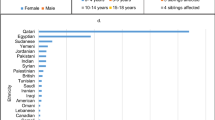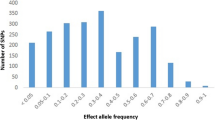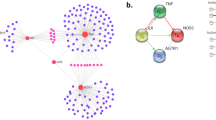Abstract
Type 1 diabetes (T1D) is a multifactorial disease that has a strong genetic component. The HLA-G is a nonclassical HLA class I locus that is associated with immunomodulatory functions, including downregulation of innate and adaptive immune responses and induction of immune tolerance. However, there is currently limited information about the involvement of HLA-G in T1D susceptibility. This case-control study aims to investigate the T1D susceptibility association of alleles and genotypes of a widely investigated 14-bp insertion/deletion polymorphism in the HLA-G and to provide further evidence of the frequency distribution of class II HLA-DR-DQ-risk genotypes in T1D children and adolescents in the Brazilian population. The deletion allele and the homozygous deletion genotype are associated with susceptibility to T1D and the insertion allele and the heterozygous deletion/insertion genotype are associated with protection from T1D. We also confirm that genetic susceptibility to T1D is associated with the DRB1*03:01-DQA1*05:01-DQB1*02:01 and DRB1*04-DQA1*03:01-DQB1*03:02 haplotypes in Brazilian northeast region. The DR3-DQ2/DR4-DQ8 genotype conferred the highest detected risk for T1D. Our results identify a novel association of the 14-bp deletion allele and the homozygous deletion genotype with T1D development and provide additional evidence of the importance of HLA class II heterozygous DR3-DQ2/DR4-DQ8 genotype in T1D susceptibility.
This is a preview of subscription content, access via your institution
Access options
Subscribe to this journal
Receive 6 digital issues and online access to articles
$119.00 per year
only $19.83 per issue
Buy this article
- Purchase on Springer Link
- Instant access to full article PDF
Prices may be subject to local taxes which are calculated during checkout
Similar content being viewed by others
References
Care M . Standards of medical care in diabetes-2013. Diabetes Care 2013; 36 (Suppl 1): S11–S66.
Emery LM, Babu S, Bugawan TL, Norris JM, Erlich HA, Eisenbarth GS et al. Newborn HLA-DR, DQ genotype screening: age- and ethnicity-specific type 1 diabetes risk estimates. Pediatr Diabetes 2005; 6: 136–144.
Patterson CC, Dahlquist GG, Gyürüs E, Green A, Soltész G, EURODIAB Study Group. Incidence trends for childhood type 1 diabetes in Europe during 1989–2003 and predicted new cases 2005-20: a multicentre prospective registration study. Lancet 2009; 373: 2027–2033.
Caillat-zucman S, Garchon H, Timsit J, Assan R, Boitard C, Djilali-saiah I et al. Age-dependent HLA genetic heterogeneity of type 1 insulin-dependent diabetes mellitus. J Clin Invest 1992; 90: 2242–2250.
Lambert A, Gillespie K, Thomson G, Cordell H, Todd J, Gale EAM et al. Absolute risk of childhood-onset type 1 diabetes defined by human leukocyte antigen class II genotype: a population-based study in the United Kingdom. J Clin Endocrinol Metab 2004; 89: 4037–4043.
Leslie RD . Predicting adult-onset autoimmune diabetes: clarity from complexity. Diabetes 2010; 59: 330–331.
Moustakas AK, Papadopoulos GK . Molecular properties of HLA-DQ alleles conferring susceptibility to or protection from insulin-dependent diabetes mellitus: keys to the fate of islet beta-cells. Am J Med Genet 2002; 115: 37–47.
Van Lummel M, van Veelen PA, Zaldumbide A, de Ru A, Janssen GMC, Moustakas AK et al. Type 1 diabetes-associated HLA-DQ8 transdimer accommodates a unique peptide repertoire. J Biol Chem 2012; 287: 9514–9524.
Eike MC, Becker T, Humphreys K, Olsson M, Lie BA . Conditional analyses on the T1DGC MHC dataset: novel associations with type 1 diabetes around HLA-G and confirmation of HLA-B. Genes Immun 2009; 10: 56–67.
Teixeira AC, Souza FF, Marano LA, Deghaide NHS, Ferreira SC . The 14 bp-deletion allele in the HLA-G gene confers susceptibility to the development of hepatocellular carcinoma in the Brazilian population. Tissue Antigens 2013; 81: 408–413.
Martelli-palomino G, Pancotto JA, Muniz YC, Mendes-junior CT, Erick C, Massaro JD et al. Polymorphic sites at the 3’ untranslated region of the HLA-G gene are associated with differential HLA-G soluble levels in the Brazilian and French population. PLoS One 2013; 8: e71742.
Carosella ED, Favier B, Rouas-freiss N, Moreau P, Lemaoult J, Bm I . Beyond the increasing complexity of the immunomodulatory HLA-G molecule. Blood 2008; 111: 4862–4870.
Abediankenari S, Eslami MB, Sarrafnejad A, Mohseni M . Dendritic cells bearing HLA-G inhibit T-cell activation in type 1 diabetes. Iran J Allergy Asthma Immunol 2007; 6: 1–7.
Blaschitz A, Crisa L, Schmitt C, Fournel S, King A, Loke YW et al. HLA-G in the human thymus: a subpopulation of medullary epithelial but not CD83 (+) dendritic cells expresses HLA-G as a membrane-bound and soluble protein. Int Immunol 1999; 11: 889–898.
Cirulli V, Zalatan J, Mcmaster M, Prinsen R, Salomon DR, Ricordi C et al. The class I HLA repertoire of pancreatic islets comprises the nonclassical class Ib antigen HLA-G. Diabetes 2006; 55: 1214–1222.
Castelli EC, Veiga-castelli LC, Yaghi L, Moreau P, Donadi EA . Transcriptional and posttranscriptional regulations of the HLA-G Gene. J Immunol Res 2014; 2014: 734068.
Amodio G, De Albuquerque RS, Gregori S . New insights into HLA-G mediated tolerance. Tissue Antigens 2014; 84: 255–263.
Twito T, Joseph J, Mociornita A, Rao V, Ross H, Delgado DH . The 14-bp deletion in the HLA-G gene indicates a low risk for acute cellular rejection in heart transplant recipients. J Heart Lung Transplant 2011; 30: 778–782.
Misra MK, Prakash S, Kapoor R, Pandey SK, Sharma RK, Agrawal S . Association of HLA-G promoter and 14-bp insertion – deletion variants with acute allograft rejection and end-stage renal. Tissue Antigens 2013; 82: 317–326.
Borghi A, Rizzo R, Corazza M, Bertoldi AM, Bortolotti D, Sturabotti G et al. HLA-G 14-bp polymorphism: a possible marker of systemic treatment response in psoriasis vulgaris? Preliminary results of a retrospective study. Dermatol Ther 2014; 27: 284–289.
Lee YH, Bae SC, Song SG . Meta-analysis of associations between functional HLA-G polymorphisms and susceptibility to systemic lupus erythematosus and rheumatoid arthritis. Rheumatol Int 2015; 35: 953–961.
Courtin D, Milet J, Sabbagh A, Massaro JD, Castelli EC, Jamonneau V et al. Infection, genetics and evolution HLA-G 3 0 UTR-2 haplotype is associated with human African trypanosomiasis susceptibility. Infect Genet Evol 2013; 17: 1–7.
Xu H, Shi W, Lin A, Yan W . HLA-G 3′ untranslated region polymorphisms influence the susceptibility for human papillomavirus infection. Tissue Antigens 2014; 84: 216–222.
Haddad R, Cilião Alves DC, Rocha-Junior MC, Azevedo R, Pombo-de-Oliveira MS, Takayanagui OM et al. HLA-G 14-bp Insertion/Deletion Polymorphism Is a Risk Factor for HTLV-1 Infection. AIDS Res Hum Retroviruses 2011; 27: 283–288.
Veit TD, Vianna P, Xavier RM, Delgado-can A, Gutierrez JE, Carneiro AP et al. Association of the HLA-G 14-bp insertion/deletion polymorphism with juvenile idiopathic arthritis and rheumatoid arthritis. Tissue Antigens 2008; 71: 440–446.
Fabris A, Segat L, Catamo E, Morgutti M, Vendramin A, Crovella S . HLA-G 14 bp deletion/insertion polymorphism in celiac disease. Am J Gastroenterol 2010; 106: 139–144.
Jeong KH, Kim SK, Kang BK, Chung JH, Shin MK, Lee MH . Association between an HLA-G 14 bp insertion/deletion polymorphism and non-segmental vitiligo in the Korean population. Arch Dermatol Res 2014; 306: 577–582.
Xue S, Yang J, Yao F, Xu L, Fan L, Fan L . Recurrent spontaneous abortions patients have more 1 14 bp heterozygotes in the 3 # UT region of the HLA-G gene in a Chinese Han population. Tissue Antigens 2007; 69: 153–155.
Steck AK, Rewers MJ . Genetics of type 1 diabetes. Clin Chem 2011; 57: 176–185.
Thomson G, Valdes AM, Noble JA, Kockum I, Grote MN, Najman J et al. Relative predispositional effects of HLA class II DRB1-DQB1 haplotypes and genotypes on type 1 diabetes: a meta-analysis. Tissue Antigens 2007; 70: 110–127.
Valdes AM, Erlich HA, Carlson J, Varney M, Moonsamy PV, Noble JA . Use of class I and class II HLA loci for predicting age at onset of type 1 diabetes in multiple populations. Diabetologia 2012; 55: 2394–2401.
Nejentsev S, Howson JMM, Walker NM, Szeszko J, Sarah F, Stevens HE et al. Localization of type 1 diabetes susceptibility to the MHC class I genes HLA-B and HLA-A. Nature 2007; 450: 887–892.
With C, Ii RC, Lipponen K, Gombos Z, Kiviniemi M, Siljander H et al. Effect of HLA class I and class II alleles on progression from autoantibody positivity to overt type 1 diabetes in children with risk-associated class II genotypes. Diabetes 2010; 59: 3253–3256.
Castelli EC, Moreau P, Oya A, Mendes-junior CT, Antonio E . In silico analysis of microRNAS targeting the HLA-G 3=untranslated region alleles and haplotypes. Hum Immunol 2009; 70: 1020–1025.
Lucena-Silva N, de Souza VS, Gomes RG, Fantinatti A, Muniz YC, de Albuquerque RS et al. HLA-G 3′ untranslated region polymorphisms are associated with systemic lupus erythematosus in 2 Brazilian populations. J Rheumatol 2013; 40: 1104–1113.
Tureck LV, Santos LC, Wowk PF, Mattar SB, Silva JS, Roxo VMMS et al. HLA-G 5 ′ URR SNPs and 3 ′ UTR 14-bp insertion/deletion polymorphism in an Afro-Brazilian population from Parana State. Int J Immunogenet 2014; 41: 29–33.
Goul S, Hantash BM, Zhao L, Faber C, Bzorek M, Holst M et al. The expression and functional activity of membrane-bound human leukocyte antigen-G1 are influenced by the 3 0 -untranslated region. Hum Immunol 2013; 74: 818–827.
Rizzo R, Hviid TVF, Govoni M, Padovan M, Rubini M, Melchiorri L et al. HLA-G genotype and HLA-G expression in systemic lupus erythematosus: HLA-G as a putative susceptibility gene in systemic lupus erythematosus. Tissue Antigens 2008; 71: 520–529.
Rizzo R, Rubini M, Govoni M, Padovan M, Melchiorri L, Stignani M et al. HLA-G 14-bp polymorphism regulates the methotrexate response in rheumatoid arthritis. Pharmacogenet Genomics 2006; 16: 615–623.
Rizzo R, Bortolotti D, Ben N, Rotola A, Cura F, Castellazzi M et al. Role of HLA-G 14 bp deletion/insertion and+3142C>G polymorphisms in the production of sHLA-G molecules in relapsing-remitting multiple sclerosis. Hum Immunol 2012; 73: 1140–1146.
García-gonzález IJ, Valle Y, Rivas F, Figuera-villanueva LE, Muñoz-valle JF, Flores-salinas HE et al. The 14 bp Del/Ins HLA-G polymorphism is related with high blood pressure in acute coronary syndrome and type 2 diabetes mellitus. Biomed Res Int 2014; 2014: 898159.
Solini A, Muscelli E, Stignani M, Melchiorri L, Santini E, Rossi C et al. Soluble human leukocyte antigen-G expression and glucose tolerance in subjects with different degrees of adiposity. J Clin Endocrinol Metab 2010; 95: 3342–3346.
Cheung YH, Watkinson J, Anastassiou D . Conditional meta-analysis stratifying on detailed HLA genotypes identifies a novel type 1 diabetes locus around TCF19 in the MHC. Hum Genet 2011; 129: 161–176.
Cifuentes RA, Rojas-Villarraga A, Anaya J-M . Human leukocyte antigen class II and type 1 diabetes in Latin America: a combined meta-analysis of association and family-based studies. Hum Immunol 2011; 72: 581–586.
Rojas-Villarraga A, Botello-Corzo D, Anaya J-M . HLA-Class II in Latin American patients with type 1 diabetes. Autoimmun Rev 2010; 9: 666–673.
Alves C, Meyer I, Vieira N, Toralles MBP, LeMaire D . [Distribution and frequency of HLA alleles and haplotypes in Brazilians with type 1 diabetes mellitus]. Arq Bras Endocrinol Metabol 2006; 50: 436–444.
Brandao LC, Vatta S, Guimaraes R, Segat L, Araujo J, De Lima Filho JL et al. Rapid genetic screening for major human leukocyte antigen risk haplotypes in patients with type 1 diabetes from Northeastern Brazil. Hum Immunol 2010; 71: 277–280.
Hviid TVF, Christiansen OB . Linkage disequilibrium between human leukocyte antigen (HLA) class II and HLA-G —possible implications for human reproduction and autoimmune disease. Hum Immunol 2005; 66: 688–699.
Eike MC, Humphreys K, Becker T, Olsson M, Lie BA . Three microsatellites from the T1DGC MHC data set show highly significant association with type 1 diabetes, independent of the HLA-DRB1, -DQA1 and -DQB1 genes. Diabetes Obes Metab 2009; 11: 17–24.
Komulainen J, Kulmala P, Savola K, Lounamaa R, Ilonen J, Reijonen H et al. Clinical, autoimmune, and genetic characteristics of very young children with type 1 diabetes. Diabetes Care 1999; 22: 1950–1955.
Hathout EH, Hartwick N, Fagoaga OR, Colacino AR, Racine M, Nelsen-cannarella S et al. Clinical, autoimmune, and HLA characteristics of children diagnosed with type 1 diabetes before 5 years of age. Pediatrics 2003; 111: 860–863.
Dang MN, Mary Q . Epigenetics in autoimmune diseases with focus on type 1 diabetes. Diabetes Metab Res Rev 2013; 29: 8–18.
Varney MD, Valdes AM, Carlson JA, Noble JA, Tait BD, Bonella P et al. HLA DPA1, DPB1 alleles and haplotypes contribute to the risk associated with type 1 diabetes. Diabetes 2010; 59: 2055–2062.
Borchers A, Uibo R, Gershwin M . The geoepidemiology of type 1 diabetes. Autoimmun Rev 2010; 9: A355–A365.
Silveira A, Gomes M, Gomes J, Rosa A, Regina S, Neumann J et al. HLA-A, -B, and -DRB1 allelic and haplotypic diversity in a sample of bone marrow volunteer donors from Rio Grande do Sul State, Brazil. Hum Immunol 2012; 73: 180–185.
Trajanoski D, Fidler SJ . HLA typing using bead-based methods. Methods Mol Biol 2012; 882: 47–65.
Haldane J . The estimation and significance of the logarithm of a ratio of frequencies. Ann Hum Genet 1956; 20: 309–311.
Excoffier L, Lischer HEL . Arlequin suite ver 3.5: a new series of programs to perform population genetics analyses under Linux and Windows. Mol Ecol Resour 2010; 10: 564–567.
Acknowledgements
This study was supported by CNPq research project (Grant number 620099/2008-9) and CAPES scholarship. We thank all of the volunteers who participated in this study. We are grateful for the technical support provided by students and technicians from LABMULT/UFRN/RN, LABIOMOL/UFRN/RN and FUNDHERP/SP in special to Neifi Hassan Saloum Deghaide. We also thank all of the physicians, nurses and hospital staff at HOSPED/UFRN who were involved in this study.
Author information
Authors and Affiliations
Corresponding author
Ethics declarations
Competing interests
The authors declare no conflict of interest.
Rights and permissions
About this article
Cite this article
Silva, H., Ururahy, M., Souza, K. et al. The association between the HLA-G 14-bp insertion/deletion polymorphism and type 1 diabetes. Genes Immun 17, 13–18 (2016). https://doi.org/10.1038/gene.2015.45
Received:
Revised:
Accepted:
Published:
Issue Date:
DOI: https://doi.org/10.1038/gene.2015.45
This article is cited by
-
Single-nucleotide polymorphisms as important risk factors of diabetes among Middle East population
Human Genomics (2022)
-
“HLA-G 3′UTR gene polymorphisms and rheumatic heart disease: a familial study among South Indian population”
Pediatric Rheumatology (2017)



